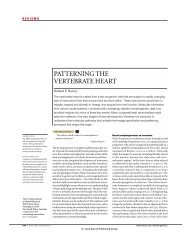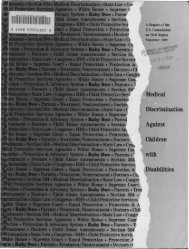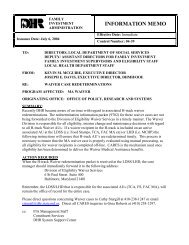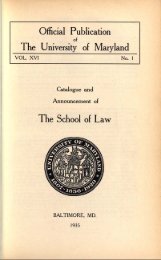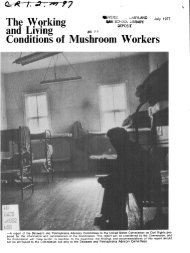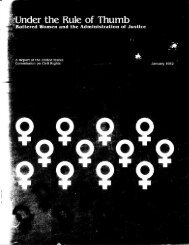y the majority male average prestige score yields theproportion <strong>of</strong> the majority score that is attained bythe women or minority men.As with the previous indicators, a ratio <strong>of</strong> 1.0would indicate the averages are equal, <strong>and</strong> a ratio <strong>of</strong>0.6 would indicate that the minority or femalegroup's average is 0.6 (or 60 percent) <strong>of</strong> the majoritymale score. Thus, the indicator directly represents theextent <strong>of</strong> disparity between the two groups' averages.Table 3.4 contains the averages <strong>and</strong> ratios <strong>for</strong> 1960,1970, <strong>and</strong> 1976.The prestige indicator values in table 3.4 <strong>and</strong>figure 3.3 show that blacks, American Indians/AlaskanNatives, Mexican Americans, <strong>and</strong>Puerto Ricans <strong>of</strong> both sexes typically have much lessprestigious occupations than majority males. Bygender, the scores are virtually identical <strong>for</strong> themajority group <strong>and</strong> very similar within most <strong>of</strong> theminority groups.The high concentration <strong>of</strong> women in a fewoccupations with relatively high prestige scores, suchas secretaries <strong>and</strong> other white collar occupations,contributes to the high average prestige scores <strong>for</strong>females. 12 Other indicators in this report emphasizemany significant differences in the occupations <strong>of</strong>males <strong>and</strong> females. There<strong>for</strong>e, this similarity inoccupational prestige scores <strong>of</strong> men <strong>and</strong> womenshould be interpreted cautiously. An indicator laterin this chapter deals specifically with the extent towhich women <strong>and</strong> minority males have occupationssimilar to majority males.None <strong>of</strong> the minority male groups shows adecrease in average prestige scores relative tomajority males. Although the changes are not verylarge <strong>and</strong> major discrepancies clearly exist, it seemsthat the trend is <strong>for</strong> minority males to be moving intomore prestigious occupations at a slow pace, but,nonetheless, at a faster rate than majority males.While the average prestige score <strong>of</strong> majority malesincreased about one percentage point during eachinterval, the other male groups' average scoresincreased more substantially. Despite more rapidmovement toward more prestigious jobs, most12 In 1973 nearly two-fifths <strong>of</strong> all women workers worked as secretaries,retail trade salesworkers, bookkeepers, private household workers, elementaryschool teachers, waitresses, typists, cashiers, sewers <strong>and</strong> stitchers, <strong>and</strong>registered nurses. U.S., Department <strong>of</strong> Labor, Employment St<strong>and</strong>ardsAdministration, <strong>Women</strong>'s Bureau, 7975 H<strong>and</strong>book on <strong>Women</strong> Workers,Bulletin 197, p. 91.13 It has been estimated, however, that it will take approximately sevengenerations <strong>for</strong> blacks <strong>and</strong> whites to have similar occupational distributions,even if discrimination were to stop immediately. See Stanley Lieberson <strong>and</strong>Glenn V. Fuguitt, "Negro-White Occupational Differences in the Absence<strong>of</strong> Discrimination," American Journal <strong>of</strong> Sociology, vol. 73, no. 2 (September1967), pp. 188-200.eMeminority male groups still have much lower presscores than majority males.The female groups show a far different patjAlthough each minority male group had its lowestindicator value <strong>of</strong> the time series in 1960 ^highest in 1976, among the female groupsfollowing had their worst scores in 1976: MeAmerican, Puerto Rican, <strong>and</strong> majority. From1976 one <strong>of</strong> the female groups' average pregicescores actually dropped in absolute as well as relatevalues, <strong>and</strong> one group's score remained the s(Q)e.Clearly, the female groups are still in a precaaapsituation without any encouraging trend. ^Occupational MobilityDisparity <strong>of</strong> occupational prestige levels bgroups can change through two processes,persons entering the labor <strong>for</strong>ce may be acinto occupations that earlier either did not exiwere closed to members <strong>of</strong> their race, ethnicor sex. Through this process, successive genera<strong>of</strong> women <strong>and</strong> minority men may becomesimilar to majority males in prestige levels M&
:fflmge that do not in fact indicate upward mobilityies <strong>for</strong> improvement.cause <strong>of</strong> this inadequacy, the indicator <strong>of</strong>pational mobility used here is based on thechange in prestige scores <strong>of</strong> those whooccupations in the past 5 years. This changeto an occupation with a similar prestige scorea higher or lower score. The indicator itself isr^ratio <strong>of</strong> the average change <strong>for</strong> minorities <strong>and</strong>voTnen to the average change <strong>for</strong> majority males.T^tadvantages discussed earlier <strong>of</strong> using ratios alsotto this indicator.the 1960 census <strong>and</strong> in the Survey <strong>of</strong> IncomeEducation in 1976, people were not asked totheir occupation 5 years earlier, so this indicatorol DfTc Occupational mobility is only available from thecensus; that is, <strong>for</strong> the 1965 to 1970 period. ThelnMsator values are contained in figure 3.4 <strong>and</strong> in3.5, which also includes the average change inge scores <strong>for</strong> those who changed occupations,w <strong>of</strong> the differences between the majority malesanjL the other groups are large enough to bestatically significant. The primary statistical reasonhis is the large variation in change scores thatbe observed in table C-2 in appendix C. Thecan American males show substantial relativebut the Mexican American, Chinese American,Pilipino American females all are far belowrity males. It should be recalled from theItous indicator that the absolute level <strong>of</strong> prestigeinority <strong>and</strong> female groups in 1970 was stilllower than <strong>for</strong> majority males, despite thed mobility <strong>of</strong> some <strong>of</strong> those who changedpupations.Occupational Segregation^ie critical issue <strong>of</strong> whether individuals in differhavedifferent occupations serves as theco«eptual basis <strong>for</strong> the next indicator <strong>of</strong> equality.Wrereas occupational characteristics were used <strong>for</strong>us indicators—i.e., prestige scores <strong>and</strong> educarequirementsassociated with specific occupa-—here the concern is more basic. The occupathemselvesare to be compared.occupational categories are described in note 11 above.«:, <strong>for</strong> example, Lieberson <strong>and</strong> Fuguitt, "Negro-White Occupationalfences in the Absence <strong>of</strong> Discrimination"; Reynolds Farley, "Trendscial Inequality: Have the Gains <strong>of</strong> the 1960's Disappeared in the'," American Sociological Review, vol. 42, no. 2 (April 1977), pp. 189-d Francine D. Blau, Equal Pay in the Office (Lexington, MassachuxingtonBooks, 1977).The term "segregation" reflects the extreme degree<strong>of</strong> separation <strong>of</strong> races, ethnic groups, or sexes thatcan result from deliberate acts channeling <strong>and</strong>restricting choices <strong>and</strong> opportunities. This phenomenoncan occur in the work place as well as inneighborhoods <strong>and</strong> schools. Two major types <strong>of</strong>segregation can be found in the world <strong>of</strong> work.Employment segregation implies that women <strong>and</strong>minorities have different employers than majoritymales, so that work settings are segregated. Occupationalsegregation refers to the situation in whichminorities <strong>and</strong> women have different occupations ortypes <strong>of</strong> jobs regardless <strong>of</strong> where or <strong>for</strong> whom theywork. In a hospital setting, <strong>for</strong> example, a majoritymale typically is a doctor, a woman is a nurse, <strong>and</strong> aminority male is an orderly. This type <strong>of</strong> extremeseparation <strong>of</strong> employees may be found in a variety <strong>of</strong>industries <strong>and</strong> appears to have been even morecommon in the past. Within the recent past, thelistings <strong>of</strong> job openings in newspapers were segregatedwith a section <strong>for</strong> males <strong>and</strong> one <strong>for</strong> females.Thus, segregation <strong>of</strong> occupations restricts women,minority males, <strong>and</strong> even majority males from full<strong>and</strong> fair access to the available positions in the labormarket.The occupational segregation indicator, usingcomparisons to majority male occupations, allowsmeasurement <strong>of</strong> the degree to which occupationalsegregation exists <strong>and</strong> has changed in the recent past<strong>for</strong> minorities <strong>and</strong> women. This indicator, like theprevious two based on occupational prestige, requiresa classification <strong>of</strong> jobs. The classificationscheme used in this report is the most detailed thatthe Bureau <strong>of</strong> the Census <strong>of</strong>fers, consisting <strong>of</strong> 441categories <strong>of</strong> occupations. 16To measure occupational segregation, the statisticaltechnique called the "index <strong>of</strong> dissimilarity" wasutilized. This index is a summary measure <strong>of</strong> theoverall differences between two percentage distributions.It has received wide use by others to measureoccupational differences, 17 as well as residentialsegregation 18 <strong>and</strong> other types <strong>of</strong> differences. Althoughpreviously the index <strong>of</strong> dissimilarity hastypically been used with the 12 major categories, it is18 Karl E. Taeuber <strong>and</strong> Alma F. Taeuber, Negroes in Cities: ResidentialSegregation <strong>and</strong> Neighborhood Changes (Chicago: Aldine, 1965); Thomas L.Van Valey, Wade Clark Ro<strong>of</strong>, <strong>and</strong> Jerome E. Wilcox, "Trends inResidential Segregation: 1960-1970," American Journal <strong>of</strong> Sociology, vol. 82,no. 4 (January 1977), pp. 826-44; <strong>and</strong> Leslie Hollingsworth, Jr., "Indexes <strong>of</strong>Racial Residential Segregation <strong>for</strong> 109 Cities in the United States, 1940 to1970," Sociological Focus, vol. 8, no. 2 (April 1975), pp. 125-42.39
- Page 1 and 2: Thurgood Marshall Law LibraryThe Un
- Page 5: Letter of TransmittalU.S. COMMISSIO
- Page 8 and 9: Contents1. Introduction 12. Educati
- Page 11 and 12: CJupter 1Introductionr stematic eva
- Page 13 and 14: nWiave different geographic distrib
- Page 15 and 16: Craipter 2lucation/, education is p
- Page 17 and 18: Social Indicator Values: Ratios of
- Page 19 and 20: ;ame incomes as those who complete
- Page 21 and 22: Social Indicator Values: Ratios of
- Page 23 and 24: Social Indicator Values: Ratios of
- Page 25 and 26: Social Indicator Values: Ratios of
- Page 27 and 28: ;orae consequences of educational a
- Page 29 and 30: catiSocial Indicator Values: Ratios
- Page 31 and 32: Social Indicator Values: Ratios of
- Page 33 and 34: Earnings$16,000"Majority Males14,00
- Page 35 and 36: Social Indicator Values: Ratios of
- Page 37 and 38: suWeed in completing a college educ
- Page 39 and 40: number of persons who were not work
- Page 41 and 42: Social Indicator Values: Ratios of
- Page 43 and 44: Social Indicator Values: Ratios of
- Page 45 and 46: cupationTABLE 3.3Prestige Scores fo
- Page 47: Social Indicator Values: Ratios of
- Page 51 and 52: Social Indicator Values: Ratios of
- Page 53 and 54: Compared with majority males.! Male
- Page 55 and 56: some groups, the dissimilarity was
- Page 57 and 58: #(Mipter 4Income and Povertybased o
- Page 59 and 60: TABLE 4.1Median Income of Families:
- Page 61 and 62: Social Indicator Values: Ratios of
- Page 63 and 64: smre the ratio was higher at 0.52 i
- Page 65 and 66: Earnings Ralros for Adjusted(group/
- Page 67 and 68: Earnings$16,000^Majority Males14,00
- Page 69 and 70: InSocial Indicator Values: Ratios o
- Page 71 and 72: TABLE 4.5erty Cutoffs in 1975 by Se
- Page 73 and 74: Familiesand UnrelatedIndividualsAme
- Page 75 and 76: alWus government programs. If the P
- Page 77 and 78: Carter 5MousingWK statistical repor
- Page 79 and 80: filar climate and housing market) a
- Page 81 and 82: i uSocial Indicator Values: Ratios
- Page 83 and 84: Social Indicator Values: Ratios of
- Page 85 and 86: in the other housing indicators, mi
- Page 87 and 88: All Households-Renter OccupiedAmer.
- Page 89 and 90: general, minority homeowners were m
- Page 91 and 92: Social Indicator Values: Ratios of
- Page 93 and 94: Social Indicator Values: Ratios of
- Page 95 and 96: about one-half to two-thirds as lik
- Page 97 and 98: mal tables that made up the primary
- Page 99 and 100:
stments to them. Through these indi
- Page 101 and 102:
IIT^) 1anpmeownership. Homes of maj
- Page 103 and 104:
g on the work begun in the Commerce
- Page 105 and 106:
Ed. PrestigeOccupational Title Req.
- Page 107 and 108:
21HsusWe Occupational Title«5 Insp
- Page 109 and 110:
nsus Ed. Prestigeode Occupational T
- Page 111 and 112:
susde Occupational Title|63 Sewers
- Page 113 and 114:
Occupational TitleGanged Occupation
- Page 115 and 116:
$364.62 will be added to the estima
- Page 117 and 118:
GroupFemaleConstantBAgeBSchoolYBPre
- Page 119 and 120:
"majority" was identified as the po
- Page 121 and 122:
Number of Cases for Each Social Ind
- Page 123 and 124:
INCOME AND POVERTYGroupTextTableSoc
- Page 125 and 126:
Number of Unweighted Cases for Each
- Page 127 and 128:
TABLE C-2Standard Deviations for Pr
- Page 129 and 130:
flrrnings Differential for College-
- Page 131 and 132:
trP persons would have less income
- Page 133 and 134:
Part II:Computer ProgramsFOLLOWING
- Page 135 and 136:
I FORMAT(1X,2A4,A2,I4,1X,2I4)f1 WKE
- Page 137 and 138:
T MEDIUMCASESCATEE LABELSHOURS1 55-
- Page 139 and 140:
IIMENT(FOR NON-HEAD TO INSURE RIGHT
- Page 141 and 142:
INTEGER OCC,SEX,AGE,IDDIMENSION X(1
- Page 143 and 144:
(SET EQ 4) G4 = 1.0(SET EQ 5) G5 =
- Page 145 and 146:
STATE(43)=22.99STATE(81)=3.42STATE(
- Page 148:
U. S. COMMISSION ON CIVIL RIGHTSWAS




